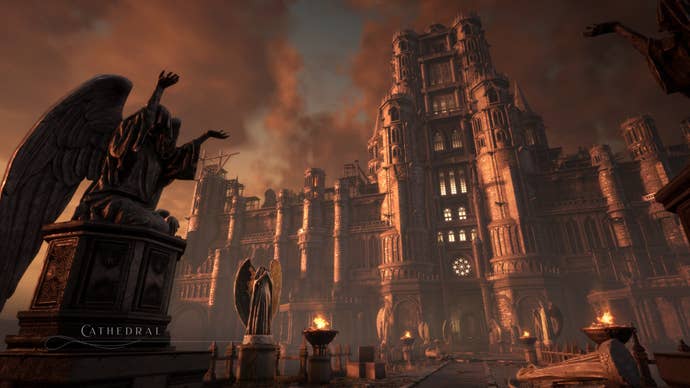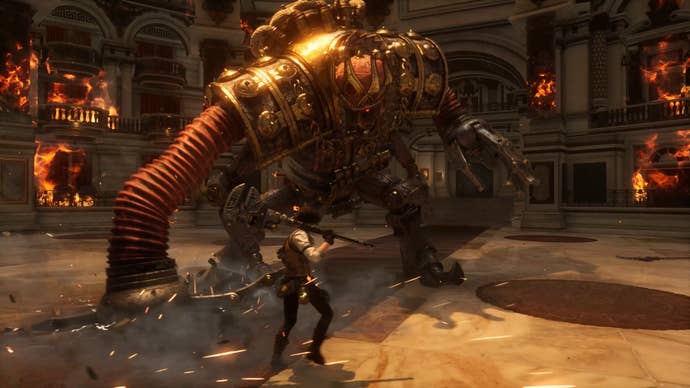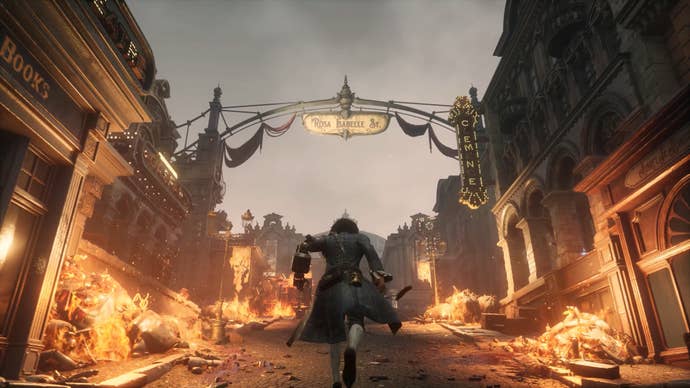Lies of P review: One of 2023’s most frustrating games is a hard sell, even on Game Pass
A lot of games miss the mark as often as they deliver, but few are as mundane as Lies of P.
Lies of P is a game of two halves, both of which are underwhelming. The story is a retelling of the Adventures of Pinocchio, set in a world that owes some of its looks to Bloodborne’s Yharnam, and Steelrising’s 18th Century Paris. Outside of being aware of the idea that its nose grows every time P tells a lie, I’m not familiar with the story of Pinocchio, so I didn’t have any expectations about the narrative one way or another.
But Lies of P’s looks aren't so much inspired by those games, they’re a pale imitation. Cobblestone streets, dimly-lit alleyways, gaslit street lamps, candlelight shining through house windows, behind which sit heavy-accented NPCs who have three lines of dialogue. It doesn’t offer any new take on its aesthetics, and seems content to just remind you of things you’ve seen before.
The deeper into the game I got, the more that became nakedly apparent. If you ever played a Souls-like, you know that the worst of them tend to lift elements wholecloth from the better ones (and FromSoft’s own work) without justifying their existence, or really understanding the circumstances that birthed them in the first place.
Lies of P has a few negative status effects, so they’re distributed amongst its various levels. There’s the overheat level, the corrosion level, the electric shock level, and so on. Almost as if it’s following a script. There are items to counteract said effects, of course, because you need them. Just like those other games.
Much of the game’s level design lacks inspiration. The general theme seems to be: Belle epoque period piece, except it’s puppets instead of people. You visit a puppet factory, a circus of a sort, a police station. All looking very appropriate for the time, but you’re not fighting humans or monsters, only puppet imitations of them – literally and figuratively.

In this story, puppets have repelled against their makers, broke their moral code and started attacking people. The few left are in hiding, but as P, you’re the only sentient puppet that’s seemingly not gone berserk. There’s great distrust between people and machines, which the game presents as justification for lying/telling the truth to matter. Occasionally, certain conversations will offer two choices, one is clearly a lie and the other the truth.
The game suggests that your decisions change the ending, but the choices I’ve come across all seem perfunctory, leading to the same outcome and only changing the dialogue. I’ve yet to see any real effect of my lies, but maybe that’s some secret the game is keeping for players to discover on their own. I just didn’t care to.
Even in the rare, unique NPC encounter and a neat (but not-very-compelling) mini-game about answering riddles on a telephone, Lies of P can’t help but lean on familiar tropes. You’ll come across your characters driven-mad, the rabble taking advantage of the chaos, a class of hunters who go after machines indiscriminately, a few environmental riddles that test you perception, and the occasional oblique dialogue about past events or important people to pad the lore. It all lacks that knowing nod and smile FromSoft has come to excel at.

The other half of Lies of P is its combat. Much like the rest of the game, this is also an element that borrows from others without making a compelling argument for it. This is standard stamina-based combat. You have light and special attacks. You can block, and dodge/roll. The only remotely interesting twist here is that blocking does not negate damage. Instead, your health bar takes a hit, represented by a grey colour. If you land a few hits on your attacker, you can regain that health back.
It’s a sort-of faint apparition of a similar system in Bloodborne, except, of course, in FromSoft’s game it made sense because you couldn’t block, so there needed to be a way to incentivise players to stay on the offensive and trade blows with enemies. In Lies of P, you can dodge – negating all damage. Invincibility frames are generous, so blocking is immediately made redundant, especially because it also costs stamina (as well as health).
Deeper into the game, you realise that blocking is actually going to be required, because certain enemies (most notably bosses) fall back on the tired old trope of having rapid, longer attack chains than you can possibly dodge, so you’re forced to block some and doge others.
I’d be fine with dancing to that tune if that’s rhythm the game wants, but it quickly devolves into a guessing game of trying to fish for certain, easily-dodgeable attacks, and “tanking” the faster ones that follow.
What’s more frustrating than anything, however, is just how animation-lead combat is. You can’t cancel out of most attacks, and you often unknowingly queue up follow-ups without wanting to. It doesn’t help that bosses don’t obey the same laws you do, and could go on multi-hit chains and only leave a small opening for you to retaliate. Others have massive area-clearing attacks that you can’t help but eat if you want to keep up the momentum. And a few suffer from the same ol’ pains of of poor tracking that come with massive enemies twirling around you in a way that’s hard to read or anticipate. That’s a FromSoft quirk the devs could have chosen to leave out, but here we are.
The sluggishness is best represented in your knockback animation; the time it takes you to get back up after getting knocked on your arse is enough to eat another hit on wakeup. It’s infuriating.

Lies of P tries to set its action apart by needlessly bolting phatic mechanics on to its already lacklustre combat. There’s stagger, which is meant to reward you for landing successful hits by opening your enemy up for a major attack that deals heavy damage. In order to trigger that stagger, however, you need to land a charged special attack. The window is so narrow, and the attack animation so lengthy, however, that I only managed to land it by luck.
Over time, your home base grows with more vendors, which unlocks an excessive list of upgrades. You can separate weapons from their handles, which is a neat idea, but has such a minimal effect on combat that I never bothered with it. Then there are the passive upgrades to your P Organ – effectively your heart – which boost your stagger damage, reduce stamina cost on block, and so on.
But that’s not all, you also have your Legion Arm, which can be equipped with different tools/weapons that turn it into a second weapon, of sorts. You may fashion it into a shield, a hand cannon, or a grappling hook to drag enemies towards you. Every one of those mechanics has one or two layers of its own, too.
I appreciate the effort that went into all those systems, but the core combat just isn’t good enough, nor the encounter design interesting enough to warrant doing anything but sticking with the most efficient, least aggravating combo. It’s wasted potential, and I doubt most players will care about – or even realise – all that depth.

I was reminded of The Surge 2 often during my time with Lies of P. They share an uncanny commitment to aping Souls-like systems and layering more and more of them on top of each other without making a real case for them.
One could charitably see both as well-meaning, if lacking the precision to execute on their aspirations. That may well be true, but it doesn’t make playing the video game any more fun.
There’s some enjoyment to be found in Lies of P. Its action is competent, but lacks the polish and stir of its contemporaries. Its atmosphere can be engrossing, but it’s a hodgepodge of themes and aesthetics you’ve seen before that never rises above the familiar. I was never impressed by it, and I never stopped questioning the point of the entire endeavour throughout my time with it.
Version tested: PS5. Code provided by publisher. Lies of P is also available on PC, PS4, Xbox One, and Xbox Series X/S. It’s a day-one Game Pass release on PC, and Xbox.







.jpg?width=291&height=164&fit=crop&quality=80&format=jpg&auto=webp)

